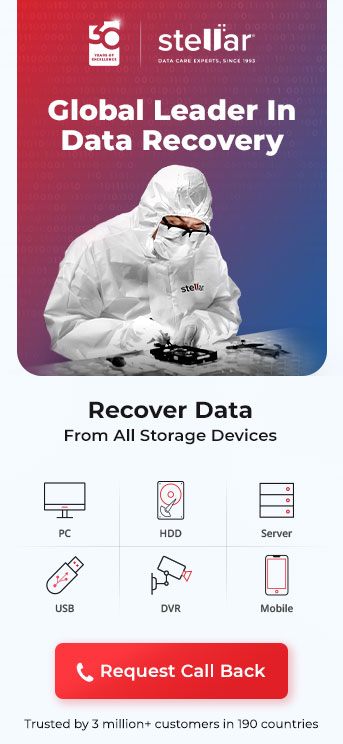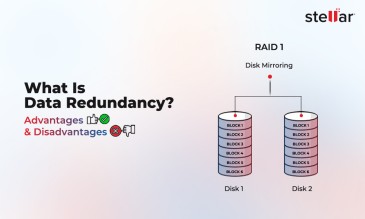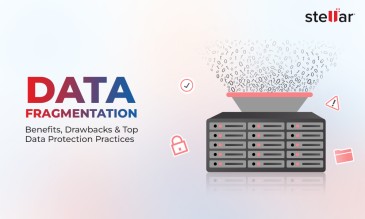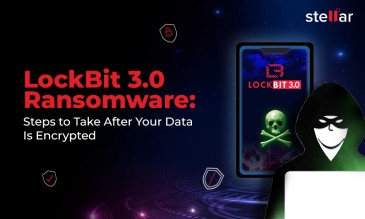The question of how to choose the right level for your RAID system is one that has plagued IT administrators and storage newbies since the different RAID versions first released.
What Is RAID? — An Overview
RAID stands for “Redundant Array (of) Independent Disks”.
In some nomenclatures, it may also be interpreted as “Redundant Array Of Inexpensive Disks”.
It is a solution that allows the same exact pieces of data to be stored across multiple hard drives.
RAID could be used for:
- For incrementing performance (higher write speeds),
- To serve as a redundancy (so that there is less chance of losing data), or
- Both of the above.
However, there are many versions of RAID out there (these are referred to as “RAID levels”).
This table summarises the key points for each RAID configuration.
| RAID Configuration | Minimum # of drives required | Capacity per drive (example) | Total JBOD capacity JBOD - Just a Bunch of Disks |
Actual % storage available | Actual storage capacity |
Disk Mirroring/ Parity |
Fault Tolerance | Read speed gain | Write speed gain |
| RAID 0 | 2 | 1 TB | 2 TB | 100% | 2 TB | Stripe only | None | 2x more | 2x more |
| RAID 1 | 2 | 1 TB | 2TB | 50% | 1 TB | Mirror only | 1 drive failure | 2x more | None |
| RAID 5 | 3 | 1 TB | 3 TB | 75% | 2.25 TB | Single Parity | 1 drive failure | 2x more | None |
| RAID 6 | 4 | 1 TB | 4 TB | 50% | 2 TB | Double Parity | 2 drive failure | 2x more | None |
| RAID 10 | 4 | 1 TB | 4 TB | 50% | 2 TB | Mirror+Stripe | 1 drive failure/pair | 4x more | 2x more |
Each RAID “level” does something differently from the last, and thus, each RAID level has its own advantages and disadvantages.
The question of how to choose the right level for your RAID system is a little more complex than just going with the naming scheme you like.
Common Types Of RAID “Levels”
The most common types of RAID levels that you will come across are the following:
- RAID 0
- RAID 01
- RAID 1
- RAID 2
- RAID 3
- RAID 4
- RAID 5
- RAID 6
- RAID 7
- RAID 10
Now, the above list makes absolutely zero sense to the uninitiated — they just seem like numbers. Also, RAID 01 is different from RAID 1, and RAID 10 is also not what it looks like.
Both of these are actually RAID 0+1 and RAID 1+0 — two very different RAID levels.
Confusing, Right?
Fret not, for this article will teach you how to choose the right level for your RAID system.
How Do RAID Levels Store Data?
RAID enabled storage solutions use two methods to store data:
- Disk Striping
- Disk Mirroring
Disk Striping is a method wherein the RAID drive will partition several hard drives, and then proceed to effectively spread that data across those several aforementioned partitions.
Think of Disk Striping like buttering a few pieces of toast — you have a big piece of data (the butter), and many pieces of toast (The RAID drives).
You will selectively butter only one side of the toast, and RAID works in much the same way.
Disk Mirroring is nothing ambiguous — like the name suggests, RAID mirroring is a process wherein one RAID disk is cloned, so that a backup of said disk exists should something happen to the original.
The question of how to choose the right level for your RAID system is greatly dependent on whether you need a performance boost, or a failsafe redundancy, or a mix of both.
Whatever the case, there is probably a RAID level for just your needs.
It should be mentioned here that having a RAID system is in no way a replacement, or even a viable substitute for having a dedicated backup drive and/or process.
Additional Reading: Raid Server Recovery – What to Do If Your RAID Server Crashes
Which RAID Level Should You Use?
Here, I will be describing the most common types of RAID levels that were mentioned earlier, and highlighting how they work.
We have two styles of RAID levels: Standard, and NESTED.
Basically, if you have a RAID drive system that uses two or more different levels of RAID, then you have a nested system, else you have a standard RAID system.
From RAID 0 through RAID 1, think of the different RAID levels like a spectrum, with RAID 0 on the extreme left, and RAID 1 on the extreme right.
The left side of this spectrum is more geared towards performance improvements, and to the right of this spectrum, the levels tend to prioritize fault tolerance and decrease data loss.
When deciding how to choose the right level for your RAID system, you will need to ask yourself where on the abovementioned spectrum you would like to fall.
1. RAID 0:
The most basic level of RAID that you can get, RAID 0 is mainly deployed on servers.
Its main purpose is to improve server performance.
RAID 0 has Disk Striping, which means that one drive is not bogged down with the task of reading data — this is spread across several disks.
RAID 0 greatly improves the speed of I/O operations (Input/ Output Operations).
RAID 0 needs a minimum of two hard drives to work, and is supported by most hardware and software RAID control systems.
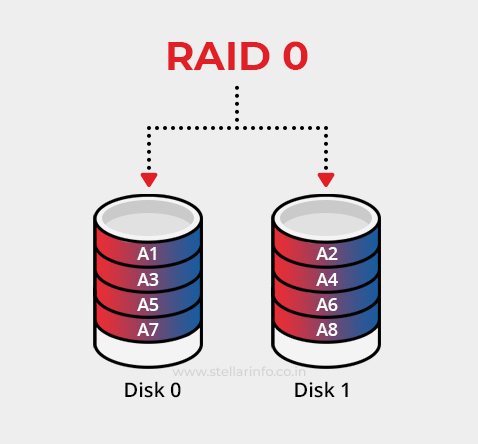
Additional Reading: How to Recover Raid 0 Data from Drive
2. RAID 01:
RAID 01 is significantly different from both RAID 1 as well as RAID 10, as you will come to see shortly.
RAID 01 is basically a level where the entire disk is mirrored onto another, but also has segments of the disk that are mapped to RAID 0.
In other words, RAID 01 is a mirrored disk that has parts of the disk set to a RAID 0 configuration.
This particular RAID level works well where performance upgrades are needed along with fault tolerance, but where scalability is not that important, because RAID 01 is hard to scale.
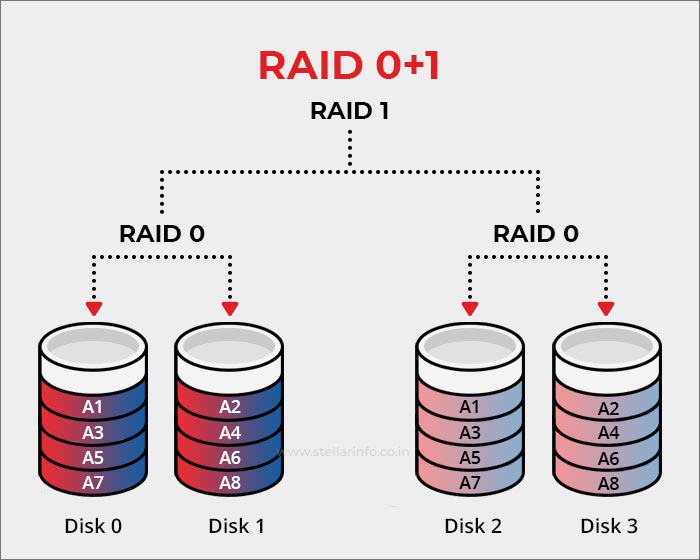
3. RAID 1:
RAID 1 is on the other end of our spectrum, prioritizing data protections and fault tolerance above anything else.
Basically, your disk will be mirrored (cloned) so that every byte of data on one disk is copied exactly “as is” to another disk.
Although RAID 1 likes a minimum of two disks to play with, you can implement it on a single drive, by means of partitioning it.
However, a key point to remember is that even though your data is safer with this level, RAID 1 will cleave your storage space in half.
For instance, if you have two 500 GB drives in a RAID one config, your effective storage space will be 500 GB, not 1 TB.
Lastly, it is worth noting that RAID 1 causes a slight drag on performance (write speeds).

4. RAID 2:
RAID 2 is strikingly similar to RAID 5 (that you will read about later), but the main difference is that the disk striping in RAID 2 configs happens at the bit-level.
The main barrier to RAID 2 solutions are the prohibitive entry costs — you’d want at least ten disks in your solution for RAID 2 to work comfortably.
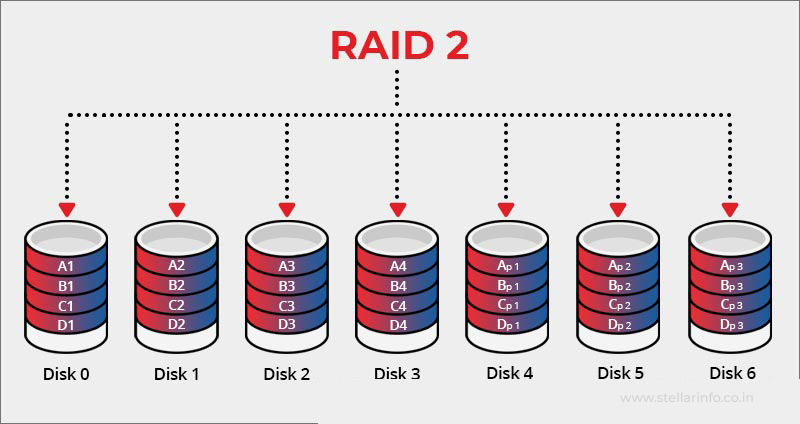
5. RAID 3:
Again, RAID 3 is also quite similar to RAID 5.
However, RAID 3 solutions demand a bona fide, dedicated drive for parity.
That is why RAID 3 is almost never used by businesses, except by full-scale data centers and the like, (those who can really benefit from that dedicated parity drive).
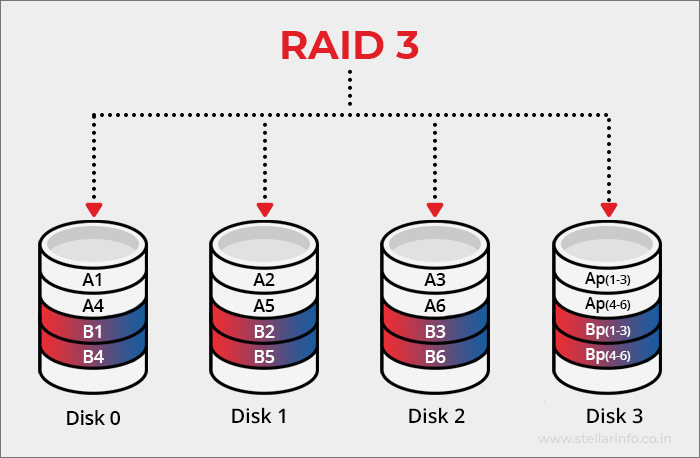
6. RAID 4:
As you can glean, RAID levels 2, 3, and 4 are simply different versions of RAID 5 that became so widely used that they warranted their own level.
RAID 4 is a level that is a copy of RAID 2. The only major difference here is that in RAID 4, the disk striping happens at the level of the byte.
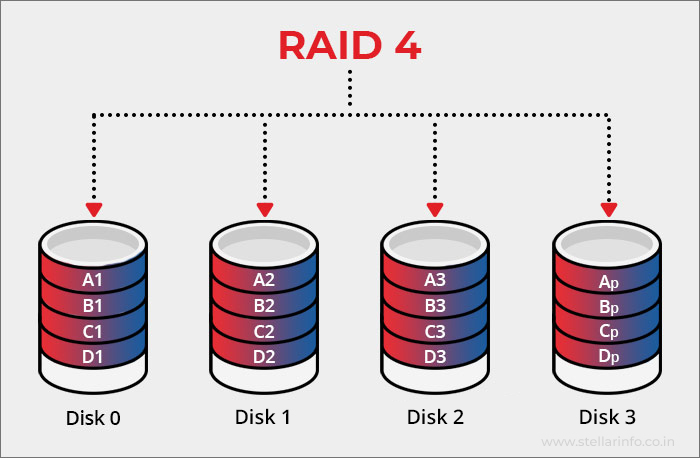
7. RAID 5:
Raid 5 is the most popular RAID level for data storage solution, by businesses and individuals alike.
RAID 5 works on the parity of blocks concept. This architecture works in a way so that the parity information is evenly striped across every single drive in the array.
Because of this equal striping, should one part of the array fail, the disk array will still be able to function.
RAID 5 offers decent performance increments given the multiple disk striping, but it is not as much of an upgrade to performance as, say, RAID 0 would offer.
RAID 5 is not considered a good solution to write-heavy workflow environments, given the performance cost of writing parity block architectures.
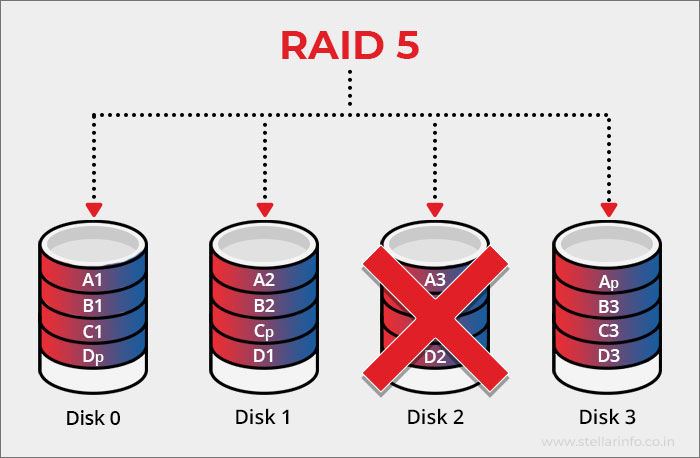
Additional Reading: How to recover data from RAID 5
8. RAID 6:
RAID 6 is often viewed as the big brother of RAID 5, because it uses parity disks instead of one.
Translation: RAID 6 is an even more robust level than RAID 5 because RAID 6 arrays can have two disks fail and still work seamlessly.
However, just like RAID 5, in the event of a failure, RAID 6 arrays can take a long while to restore after a failure.
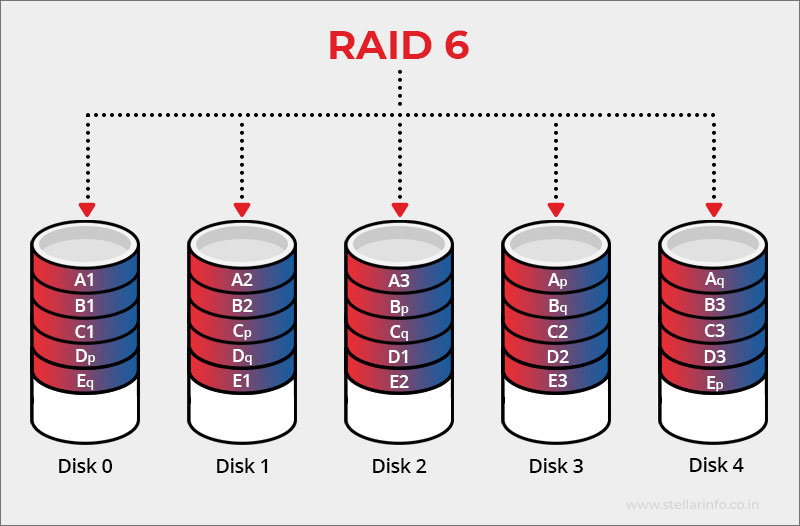
9. RAID 7:
RAID 7 was quite the revolutionary solution back in the day.
It was based off of RAID levels 3 and 4, and to this amalgamation, it added caching via a bus, and used an OS as a dedicated controller.
It still remains in use today. Though it has definitely fallen out of the mainstream use cases.
10. RAID 10:
RAID 10 (Read as RAID 1+0) is a RAID level that gives you the best performance with the striping advantages of RAID 0.
It is a “best of both worlds” solution in all its glory.
However, the main downside to RAID 10 is its restrictive cost — it needs double the number of disks of other configurations, with four drives being the minimum.
RAID 10 can also be implemented either with a hardware or software based controller, and is the ideal level for storage solutions that perform high intensity and frequent write operations.
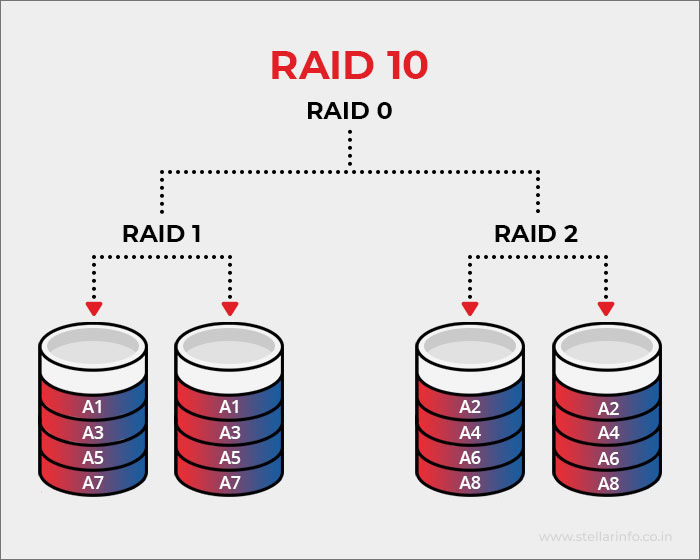
Additional Reading: How to Recover Data from RAID Server?
Things To Remember
That said, like was mentioned earlier, do not throw caution to the winds just because you have a fancy new RAID setup — even these aren't infallible.
If you do find yourself in the position where data on your RAID deployment has become inaccessible for whatever reason, and you find yourself without a backup or redundancy, the best way forward for you is to call in the pros.
At Stellar Data Recovery Services, we have decades of experience in all kinds of data recovery as well as data erasure possible.
This experience puts Stellar data recovery in the sweet spot of knowledge, know-how, and expertise to carry out data recovery for all RAID levels.
You now know how to choose the right level for your RAID system, and what each of the standard RAID systems have going for them.
As a bonus, you also learnt what some popular nonstandard versions of RAID do better than the standard levels.
Additional Reading: RAID Level 0, 1, 5, 6, and 10 – With their Uses, Advantages, and Disadvantages
About The Author

Online Marketing Expert & Content Writer






